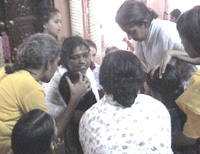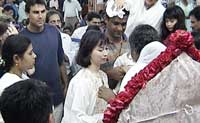-
She is still whispering

16 May, 2001, Amritapuri Today, the 16th of May, is the last scheduled public darshan before Mother leaves for the six-week US Tour. Mother came to the temple shortly after ten in the morning, and it is now nearly seven in the evening, bhajans should be in full swing, but they aren’t, for still the
-
Will Mother visit our homes?
15 May, 2001, Amritapuri The leaders of the villages Mother is adopting in Gujarat made the long train journey to southern Kerala just in time to see their new Mother before Her departure for the US Tour. They were on a mission: Representing the people of the villages where Mother is helping reconstruct homes, schools,
-
Mother’s day
13 May, 2001, Amritapuri During the last few days before Mother leaves for any extended tour, especially one to foreign countries, as if determined to have a final long swallow of water before crossing the desert, people converge on the oasis of the ashram. The crowds are huge. Baths start at about two thirty in
-
Paying back a visit
4 – 5 May, 2001, Coimbatore The last afternoon darshan in Coimbatore. The stage is packed-as usual. But the majority of devotees seated there to Mother’s left are children, girls and boys in green-checked uniforms. Why is there so much space between them? Ah! Many are sitting with their legs stretched out in front. Their
-
Brahmasthanam Installation – Covai

2 May 2001, Covai, Tamil Nadu Between the hours of eleven in the morning and one in the afternoon on Wednesday, the 2nd of May, 2001, Amma consecrated a new Brahmasthanam temple at the new ashram in Coimbatore, Tamil Nadu, the southern state neighbouring Her home state of Kerala. At Mananthavadi just over two months
-
Playful darshan

17 – 27 April 2001, AustraliaIn case you thought spirituality was only somber, reconsider. Observe Mother’s darshan programs, especially in the West, where smaller crowds allow time for Mother’s playfulness to surface even more than usual! The first night after the group’s arrival in Australia, Mother had great fun talking about the adventures of the
-
Vishu celebrations
April the 14th, 2001, marks the New Year in the Hindu calendar. The focal point of the Vishu celebrations in Amritapuri was the Kalari, where Amma first started Krishna Bhava in 1975. The vishukkani (literally, ‘first sight of the year’) was kaleidoscopic display of elaborate floral arrangements and a platter of fruits. In Indian tradition,
-
Carwashers of Adelaide
During her Australian tours, Mother doesn’t usually go to Adelaide. It’s too far off Her “beaten track” in Australia. She visits Melbourne, on the south coast, then goes up to Sydney, Brisbane and Gold Coast. Four places, public programs in each, retreats in two-but nothing in Adelaide, further west on Australia’s southern coast. But the
-
Everyone felt “at Home”

14 April 2001, SingaporeIn Singapore every year the crowds are growing larger rapidly. These crowds are also becoming more diverse. (Once the domain of immigrants from India, Mother’s programs now draw people from all backgrounds, Hindu and Buddhist and Christian alike). This tendency to diversity underscores and is a response to the universality of Mother’s
-
In the Rain!
17- 27 April, Australia Melbourne Retreat The special meditation session with Mother had been held indoors because of both cold and rain. The last mantra, “Lokah samastah sukhino bhavantu” (“May all beings in the universe be happy”) was reverberating. Then silence. Not quite. Rain. Pitter-patter. Then faster. The lights came up; Mother looked ruefully around
